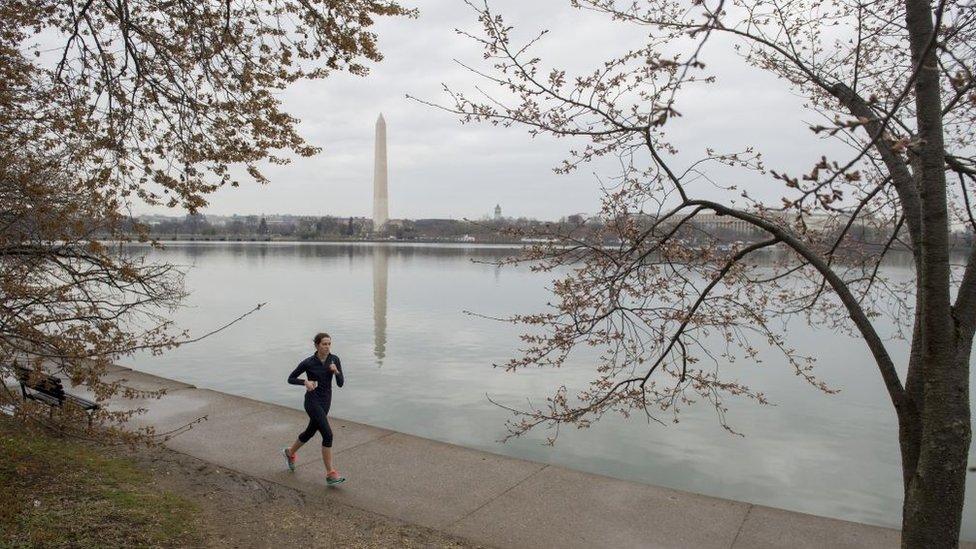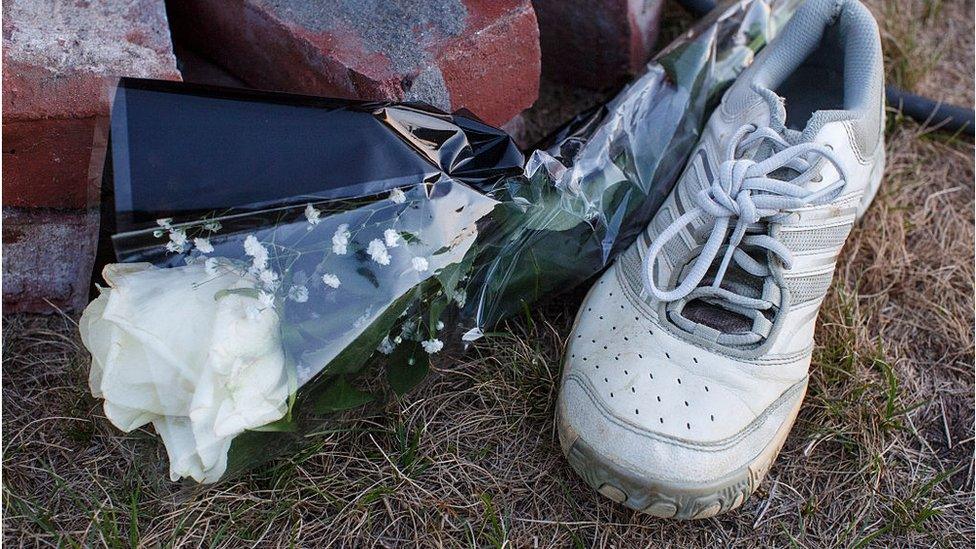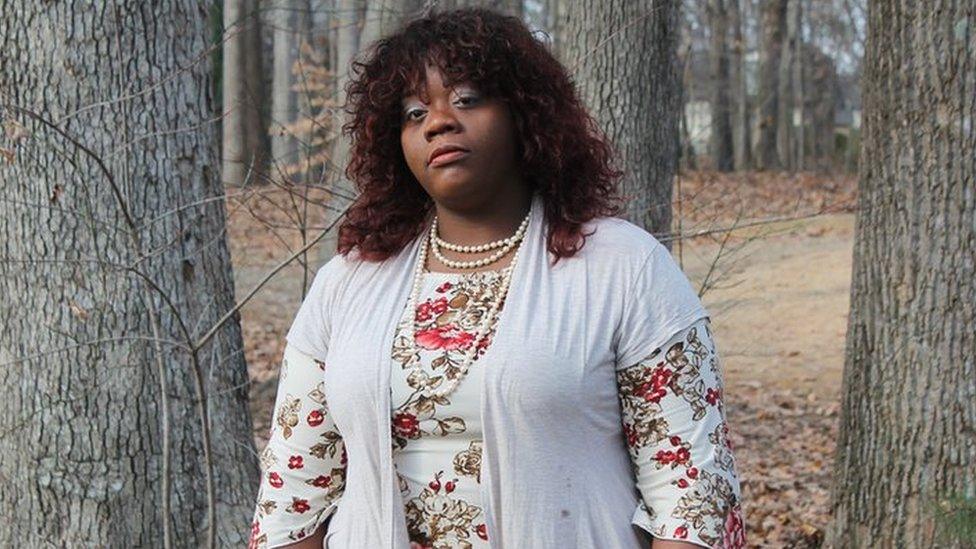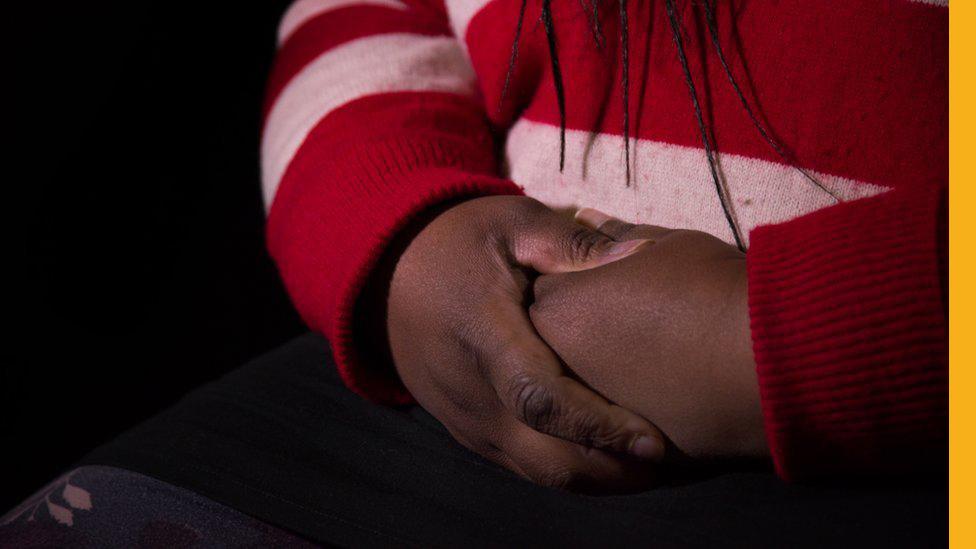From catcalls to murder: What female joggers face on every run
- Published

The vast majority of female runners say they've changed their behaviours because of harassment concerns
It happened to her during a jog on her college campus just after noon local time.
The van's driver had both his hands outstretched, holding a phone sideways, pointed directly at her as he took photos.
Meg Gibson stared the man down and his van sped off the Ohio State University grounds, tires squealing.
"At first I didn't know what to do," the 29-year-old says. "But I thought about Mollie Tibbetts."
On 21 August, 600 miles away, a young man had led police to the body of Mollie Tibbetts, 20, lying in a corn field, days after she too set off on a run.
Later, he would tell police that he "got mad" when she threatened to call 911 for following her, but he "blocked" out what happened between talking to her and finding her dead in the trunk of his car.
"When I saw two female students, I asked to use their phone," Ms Gibson says. "They told me they also had their pictures taken by the same middle-aged men in the van."
When she called the local police department, she says she was told: "What do you want me to do? There's nothing to report."
But when campus police arrived, she says, an officer told her : "You did the right thing."

In the wake of Mollie Tibbetts' death, women across the US have been honouring her with the #MilesforMollie movement - running to show that despite such a horrific loss, the running community will persevere.
This summer's tragedy echoes that of August 2016, when the murders of three female joggers spanned just nine days.
The slew of tragedies prompted the magazine Runner's World to conduct its first survey of harassment experienced by US women who run.
"What was a surprise was how men, and some women, don't see that it's a prevalent problem," says Michelle Hamilton, the journalist behind the Running While Female, external story.

Ms Tibbetts had planned to study psychology at university
The 2017 survey revealed that 43% of women experienced harassment while running - with the number rising to 58% for women under 30. Just 4% of men reported the same.
The poll also found 30% of women said they had been followed by a harasser on foot, by car or bike. And the vast majority of women said these fears led them to change their habits - to run only during the day, to change their routes, to carry pepper spray or - in the case of 1% of women - to carry a loaded gun.
Ms Hamilton recalls a huge response from male runners - a mix of support and scorn. Some called the claims ridiculous while others said women just needed to learn how to protect themselves.
"Even when they talk about murder, the question is: was she running alone? As if she shouldn't be," Ms Hamilton says. "Only now are people starting to say 'he shouldn't harass her'."
When asked if she had noticed any changes since the survey Ms Hamilton said behaviours haven't changed, but the conversations have.
The #MeToo movement, she says, is partly responsible for the shift.
"There's a growing awareness that women go through life with a very different experience than men and that experience is a level of constant fear."
Holly Kearl, founder of the nonprofit Stop Street Harassment, a group focused on ending gender-based harassment in public spaces, says she has carried mace ever since a man followed her on a run as a teenager.
"Even if a man is just whistling to you or just saying something, you never know how far that may go - and what it could escalate to," Ms Kearl says.

A running shoe and flowers at a memorial for Vanessa Marcotte, a woman murdered in 2016 while on a jog in Massachusetts.
She says what happened to Mollie Tibbetts "could have been any of us".
"We have to start in schools with boys, with young men and really work on redefining masculinity. It's a harder ask - it's much easier to tell women to not go running by themselves than to tell men to not harass them."
Kimberly Fairchild, an associate professor of psychology at Manhattan College in Riverdale, New York, says street harassment harms women on a psychological level too.
"Men use street harassment to assert power and enforce gender boundaries," she says.
"I think the #MeToo movement has helped to expose how universal the problems of harassment and assault are, but more work is needed to elaborate on the consequences and effects of harassment. From a social psychological perspective, street harassment is about power and privilege."

Self-defence for runners
Katalin Rodriguez Ogren, owner of POW Gym in Chicago, teaches self-defence classes targeted at runners. Her tips include:
Be aware of any individuals in your immediate vicinity
Pay attention to body language signals like eye contact and stance
Don't wear headphones when you might be alone or in a secluded area
Practise getting off the ground as quickly as possible
Take boxing or Muay Thai courses for the best set of applicable skills

Kyle Neal, 38, says he witnessed a situation in which a man was "lurking" around a woman who was running while listening to music.
"I confronted the man and everything de-escalated from there, but that was the first instance where I was like, this is an issue that I'd never noticed before. Since then I've been hyperaware."
He says more male runners need to think of these situations from a woman's perspective.

Avoid wearing headphones while running in order to stay vigilant, experts say
The Stop Street Harassment advocacy group reported this year that around 66% of women who suffered sexual abuse had experienced it in public spaces.
"Every woman has a street harassment story," says Sandria Washington of GirlTrek, an organisation dedicated to empowering young black women.
Ms Washington says the news of Mollie Tibbetts' death was devastating, but not surprising.
"That same scenario plays out in neighbourhoods all over the country," she says.
"One of the best ways to start having this conversation, to start helping men understand about street harassment is to constantly talk about it."

After Runner's World published Ms Hamilton's story in 2017, male runners online began talking.
Responses on the popular Let's Run online forum ranged from "all runners get heckled" to "just get a treadmill".
Most women who replied noted that their fears were due to sexual comments and inappropriate behaviours.
"You have no idea what it's like to be a female runner and have to be cautious about running in certain areas or by yourself for fear of getting attacked," a woman wrote.
But since Mollie Tibbetts' death, the issue of harassment on runs has reemerged, with men and women exchanging tips on Reddit to stay safe on runs (wear bright colours, use tracking apps, don't wear headphones).
"As I'm running, I sometimes play scenarios in my head, like 'If the guy in that car started pursuing me, where would I go?' Or 'If that guy doubled back and started following me, what could I grab to defend myself?'" a woman posted.
"At the end of the day you are your own first responder," self-defence teacher Ms Ogren says.
"You can only control what you do. Understanding what aggressive body language looks like is really important."
- Published23 August 2018

- Published11 January 2018

- Published27 March 2018

- Published12 May 2018
